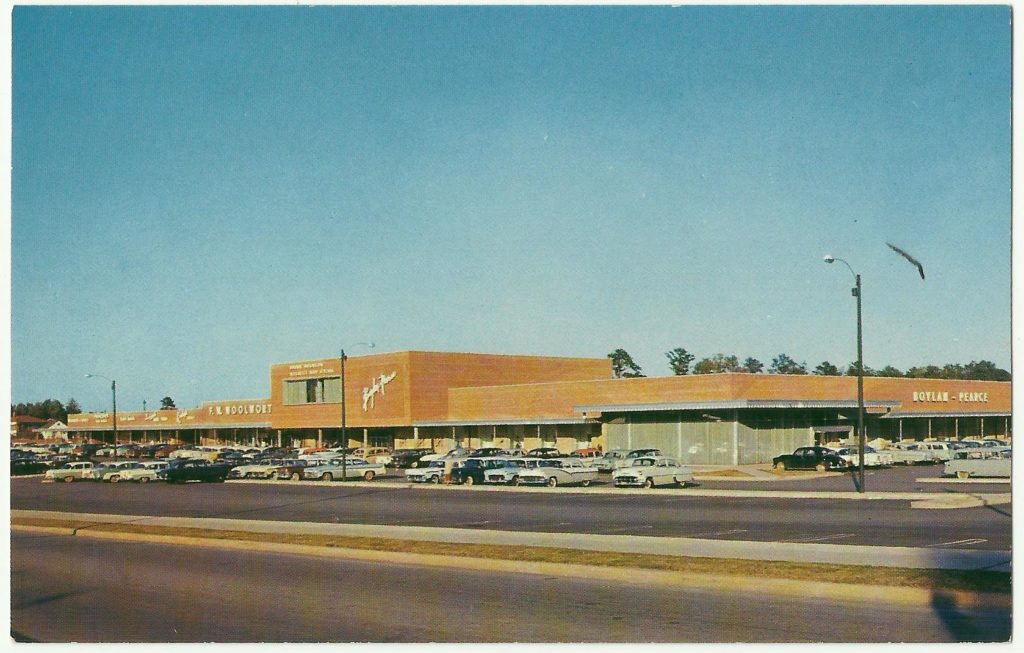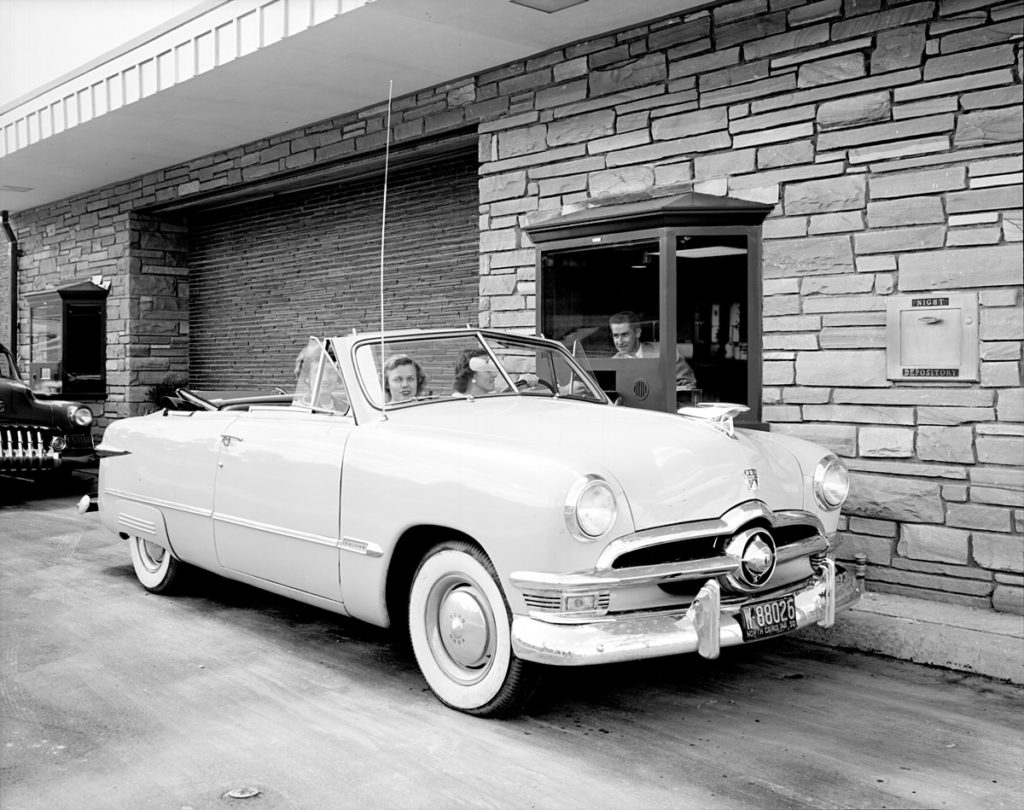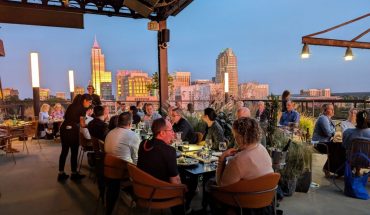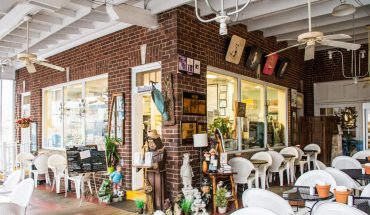As Raleigh has changed over the years, so has this historic shopping center, one of the first in the South
by Katherine Snow Smith

Raleigh native Ann Lichtner remembers visiting Santa Claus at the old Sears on Oberlin Road and grabbing a soda with her high school sweetheart, who later became her husband, at the Kerr Drug after school. Now in her 70s, she’s amazed at how much the area where these stores were centered, the Village District, has changed since then. “You could get anywhere in 10 minutes,” she says. “Our world was much smaller.”
When what was then known as Cameron Village opened in 1949, it was cutting-edge retail — part of “the story of a new trend in gracious, suburban living… planned with scientific thought,” according to a marketing pamphlet advertising for the new development. And just as Raleigh has changed over the last 80 years, the shopping center has gone through many incarnations to evolve with the times. “The original concept of six city blocks with storefront parking is here, but everything else looks completely different,” says Smedes York, a former mayor of Raleigh whose father, Willie York, developed the property.
Smedes, who’s now chairman of the board for York Properties, was 8 years old when his father opened the first suburban shopping center between Washington, D.C., and Atlanta. Cameron Village was built as a retail center with residential and office space, a departure from earlier shopping districts, which were typically built near a city’s established downtown. Its sales flyer boasted off-the-street parking and “wide, canopied sidewalks” to keep rain, sleet, or snow off the shoppers there.
The shopping center opened with four retail stores, and within a few years had 65 outlets, including Burton’s Fashions Inc., Nowell’s Clothiers, Willett’s Beauty Shop, Renn’s Toyville, Woolworth’s, Colonial grocery store (later
Big Star), and Hollowell’s Esso Service station.
“A dress or desk, a ham or hammer, a blouse or a house or a manicure… you can buy them all within a few steps,” boasts its early sales pamphlet. Medlin-Davis Cleaners, which opened here in 1950, is today one of the longest running of the earliest tenants. Lichtner remembers that many of the shops were owned by parents of her friends at Broughton High School —everyone knew everyone.
“Kerr Drug, Jolly’s Jewelers, Burton’s, and, of course, the York family, I went to school with most of those kids,” she says. Balentine’s Cafeteria is a place she remembers as a town staple. “It was a big thing, you’d go in and see people you knew, you always saw friends and parents,” says Lichtner. “Mr. Balentine would walk out and speak to everyone, he’d call you by your name.”
As a child, Smedes was a fan of The Hobby Shop for its model airplanes and Lionel Trains. He remembers winning a Schwinn bike at a raffle when Sears Roebuck and Co. opened in early 1950, and seeing his first movie — “Bedtime for Bonzo,” starring Ronald Reagan — at the Village Theater in 1951. He also liked the Stephenson Music Company: “I wasn’t much of a musician, but it was a great place to go when my friends and I were playing hide and seek,” he says. His son, George York, the current president and CEO of York Properties, remembers buying cassette tapes at the Record Bar, which opened in 1968. He also bought concert tickets there for his first show, Genesis.
But by the late 1960s, the advent of the shopping mall, with its climate-controlled hallways and abundant parking, made outdoor storefronts seem obsolete. North Hills, built in 1960, was converted from open-air shopping to a mall in 1967, and when Crabtree Valley Mall opened in 1972, Sears — and many shoppers — headed there, too.
Willie responded by adding parking decks around the shops to offer coverage during rainy or hot days. “That was his defense against the malls,” says Smedes. Unfortunately, the parking decks made shopping at Cameron Village a dark and dreary experience and blocked stores’ windows and signage. Chuck Millsaps, president of the Great Outdoor Provision Co., remembers the parking deck era with angst. “You’d be trying to tie a boat on top of somebody’s car and the wind would swoop in under that deck and blow it off,” he laughs.
So Willie tried a new tactic to attract shoppers: opening The Village Subway, an entertainment venue modeled after a similar below-decks spot in Atlanta. Located beneath the Boylan Pearce department store, where Fresh Market stands now, the clubs hosted big-name performers such as Bette Midler, Thelonious Monk, Barry Manilow, R.E.M., The Go-Gos, and Iggy Pop. Local television’s favorite piano player, Uncle Paul, serenaded guests during the daytime.
“It was a different kind of entertainment experience, the underground part of it came alive,” says Lichtner. Crowds flocked to the Village Subway, along with popular spots like The Frog & Nightgown, Elliot’s Nest, and Café Déjà Vu. It was a boon for the nightlife, but a bust for the stores by day: The Village Subway closed in 1986, with complaints that the evening crowds left the parking lots a mess.
Meanwhile, the pendulum started swinging back toward smaller scale, open-air shopping. The Yorks took down the parking decks, and some of the customers who had avoided the dark spaces returned. J.C. Penney, known simply as Penney’s to shoppers, closed in 1991. Thalhimers department store, which had been bought by Hecht’s, closed in 1992. It was time for a ‘90s makeover, so the Yorks worked with real estate consultants to move away from using department stores as anchors for the space, creating a village of smaller boutiques that was more pedestrian-friendly.
Trees, planters, and generous sidewalks invited shoppers to park and stroll its blocks, and acrylic domes over the storefronts provided shelter from sun and rain. The Yorks invited in newcomers who are now old-timers, like Cafe Carolina, H&H Shoe Repair, Bailey’s Fine Jewelry, and Johnson Lambe Sporting Goods. Regency Centers, a Jacksonville, Florida, investment group, acquired the property in 2004 (York Properties continues to manage it). And the area continued to burnish its reputation as a destination for shoppers.
Millsaps remembers one funny moment from the late 2000s: then-governor Beverly Perdue, the state’s first female governor, got the high heel of her shoe stuck in one of the knotholes in the store’s creaky, old wooden floors. “She came in for holiday shopping and broke off her high heel. We were just mortified,” Millsaps said. “She was stuck there without a shoe. Her security attaché was there. They didn’t know what to do.”
Ten years later, the advent of COVID-19 meant more rethinking of how vendors could continue to operate as best they could. The storefront parking turned out to be a godsend: soon, there were designated parking spaces for quick pick-ups, while other spots evolved into outdoor dining areas. “We were all in this together and we were trying to make it as accommodating as possible,” says George.
“And I think the outdoor dining is here to stay.” Last year, to the surprise of many, the shopping center’s name was changed in a move to sever its association with the Bennehan-Cameron Plantation of the 1800s. The move was prompted by Raleigh advocacy group Friends of Oberlin Village. “Whether written, read or spoken, words are extremely powerful,” says Sabrina Goode, the group’s executive director. “To achieve inclusivity, Raleigh’s leaders, developers, and residents must be sensitive to words that can ignite versus unite.” While it has been a tough transition for many who are used to the prior name, most understand its importance as the way forward. “It’s hard because I’ve lived here so long, and out of habit often say Cameron Village, but I acknowledge the history and think that it’s important,” says Lichtner.
As the pandemic eases, the Village District is bustling again, with teens grabbing Goodberry’s, young parents shopping at the Harris Teeter, and businesspeople sharing notes over lunch at Tazza. Alongside the locally owned businesses, boutique-style versions of retail giants Barnes & Noble and Sephora recently opened — and there’s even talk about reviving a club like the Village Underground.
For longtime residents, the returned energy reminds them of the Village District in the early days. “It’s been nice to see it evolve and there’s a sense of vibrancy there,” says Lichtner. “Each generation continues to enjoy it in different ways.”
__
This article originally appeared in the December 2021 issue of WALTER Magazine





Pingback: Shop Talk: The Evolution of the Village District - WALTER Magazine - Newz Ai